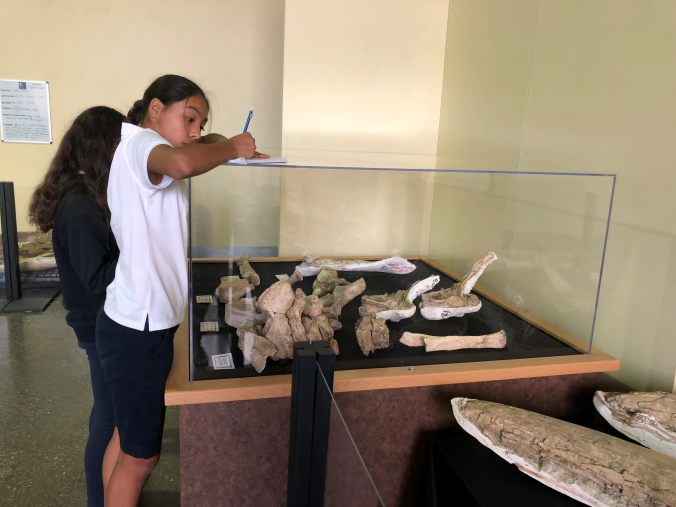by Brett Samantha Dooley, Western Science Center Educator
I am an educator at the Western Science Center (WSC) but also a graduate student in the Global PRiSE (Pragmatic Research in STEM Education) Program through Texas Tech University. As its name implies, the Global PRiSE Program seeks to build new lines of international exchange in areas including formal and informal education. My involvement with Global PRiSE has caused thoughts about global outreach to permeate through all my endeavors. Once there was a strong possibility I would begin working with WSC, I thought a partnership between two schools to build an exhibit for the museum about the Pleistocene (Ice Age) fossils that come from the region of each school would be exciting and informative.
The best way to begin was with a local and an international school partnering with WSC serving as a facilitator and providing specimens. Another interest of mine is to test whether or not students are more invested in projects with international rather than domestic partners so that future projects may include domestic partners as well.
The first part of an endeavor involving partnerships is finding participants. I approached a few high school teachers at the Western Center Academy (WCA), but their plates were too full to take on a new project. I spoke with a colleague and friend who teaches in North Carolina, but she is in her first year at a new school and couldn’t take on more. I then approached the sixth-grade science teacher who thought the project sounded interesting. One down, one to go!
Next, I had to find an international partner for the project to proceed. I worked previously with a teacher in Catalan, so I asked him if he knew of anyone interested. Alas, I did not hear back from him. Next, I tried a teacher in Russia with whom I’d been in contact, but this was not a good time for her. I posted in the KidLink Facebook group about the project, but nobody was biting. Then I asked my advisor about a teacher in Brazil he had mentioned previously, and he introduced us through an email. She is an English language teacher from Colégio Elvira Brandão in São Paulo, Brazil and thought the idea sounded wonderful. I had my two partners at last! With this, the WSC launched the I.C.E. (International Collaboration for Education) Age Project.
A natural tie-in with the sixth-grade curriculum and a comparison of Ice Age Fauna is their climate unit. The teacher in Brazil was flexible with timing, so we decided to begin the collaboration at the end of March when the climate unit began. In the interim months, we continued correspondence through Facebook Messenger and emails, and I checked in weekly with the teacher at WCA. In February, we met via Skype to discuss the project goals, a basic timeline, and plan of attack.
In late March, we were ready for students to begin! I went into the 6th-grade class and showed them some of the 3D fossils with which they could work. The students “oohed” and “ahhed;” their interest apparent as they held the prints. One student brought the back portions of a Smilodon fatalis (saber-toothed cat) dentary (jaw) up to his jaws in mock gnashing of teeth. A low murmur spread through the class when I showed them a tusk fragment of a mammoth. (Their school mascot is the Mammoth.)
The following Monday we went on a museum tour so students could focus on the exhibit panels and text to get an idea of what they would be creating as well as to see the 3D printing lab. Some of the students were quite dedicated to the task and took notes about all of the signs. I pointed out the difference in text design of the temporary exhibit, the hallway exhibit, and the mammoth remains to help them see the value text panels have and the power of limited text supplemented with visuals.

A Western Center Academy student taking notes from one of WSC’s exhibits.

Students from Western Center Academy using Google Hangouts to meet with their counterparts at Colégio Elvira Brandão.
The teacher told students to pick a favorite fossil and to begin researching. The next week students divided themselves into teams to research and write about their chosen animal and to create sketches. I went into the class each day to provide any information needed and to help the students find good web resources.
With this, the Brazilian students edited and added to the text and shared their illustrations.
When the text was ready, it was sent to the museum staff, who made final edits and placed everything into panel templates. Meanwhile, the museum had been producing 3D-printed replicas of specimens, secured a display case, and made room for the new display in the exhibit gallery.
Panels were ordered and delivered, prints were completed, and by April 25th everything was in place! To open the exhibit, we held a reception for the WCA students, faculty, and parents, with the Brazilian students present on a video call. The first I.C.E. Age Project exhibit is now up at Western Science Center for everyone to see!

Educator Brett Dooley addressing the Western Center Academy students and their families during the opening reception of their exhibit.

WCA students checking out the finished panels they helped produce.